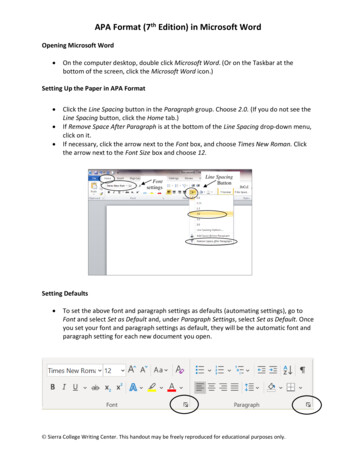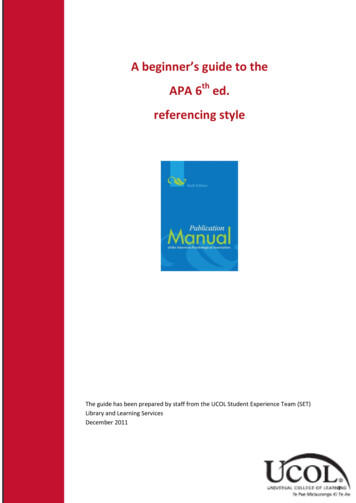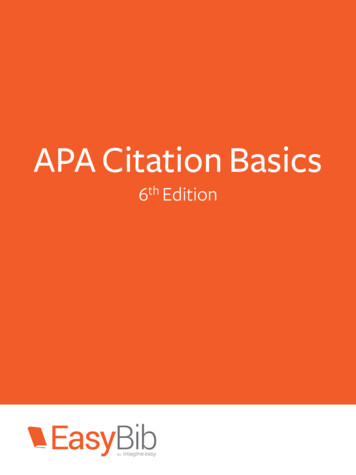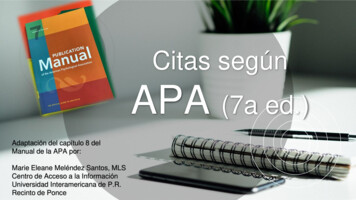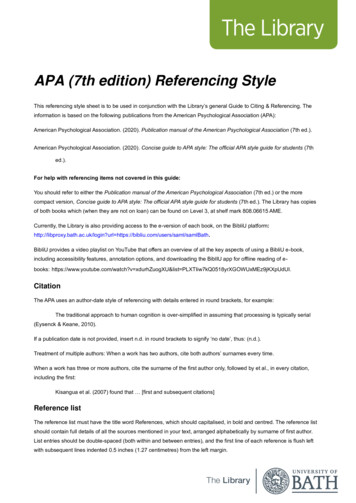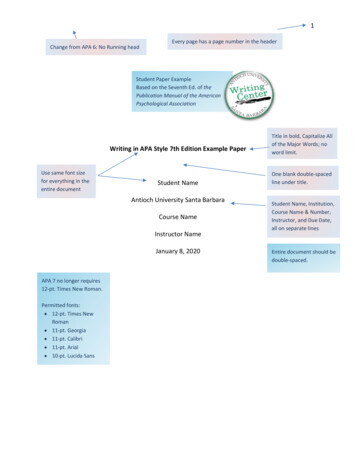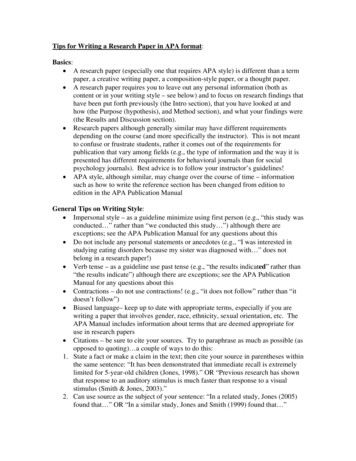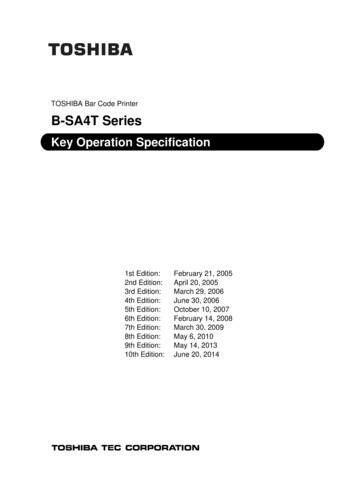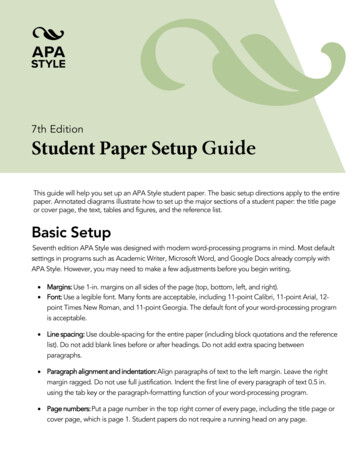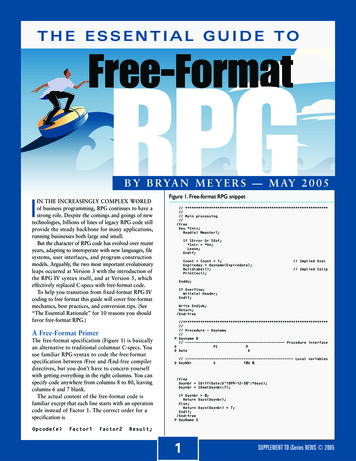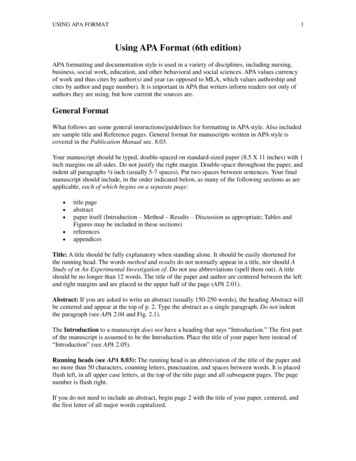
Transcription
USING APA FORMAT1Using APA Format (6th edition)APA formatting and documentation style is used in a variety of disciplines, including nursing,business, social work, education, and other behavioral and social sciences. APA values currencyof work and thus cites by author(s) and year (as opposed to MLA, which values authorship andcites by author and page number). It is important in APA that writers inform readers not only ofauthors they are using, but how current the sources are.General FormatWhat follows are some general instructions/guidelines for formatting in APA style. Also includedare sample title and Reference pages. General format for manuscripts written in APA style iscovered in the Publication Manual sec. 8.03.Your manuscript should be typed, double-spaced on standard-sized paper (8.5 X 11 inches) with 1inch margins on all sides. Do not justify the right margin. Double-space throughout the paper, andindent all paragraphs ½ inch (usually 5-7 spaces). Put two spaces between sentences. Your finalmanuscript should include, in the order indicated below, as many of the following sections as areapplicable, each of which begins on a separate page: title pageabstractpaper itself (Introduction – Method – Results – Discussion as appropriate; Tables andFigures may be included in these sections)referencesappendicesTitle: A title should be fully explanatory when standing alone. It should be easily shortened forthe running head. The words method and results do not normally appear in a title, nor should AStudy of or An Experimental Investigation of. Do not use abbreviations (spell them out). A titleshould be no longer than 12 words. The title of the paper and author are centered between the leftand right margins and are placed in the upper half of the page (APA 2.01).Abstract: If you are asked to write an abstract (usually 150-250 words), the heading Abstract willbe centered and appear at the top of p. 2. Type the abstract as a single paragraph. Do not indentthe paragraph (see APA 2.04 and Fig. 2.1).The Introduction to a manuscript does not have a heading that says “Introduction.” The first partof the manuscript is assumed to be the Introduction. Place the title of your paper here instead of“Introduction” (see APA 2.05).Running heads (see APA 8.03): The running head is an abbreviation of the title of the paper andno more than 50 characters, counting letters, punctuation, and spaces between words. It is placedflush left, in all upper case letters, at the top of the title page and all subsequent pages. The pagenumber is flush right.If you do not need to include an abstract, begin page 2 with the title of your paper, centered, andthe first letter of all major words capitalized.
USING APA FORMAT2Levels of Headings: For most undergraduate papers, one or two levels of headings will besufficient. Nevertheless, the first three levels are set up as follows (see sec. 3.03 in APA for alllevels).Level 1:Centered, Boldfaced, Capitalize all Major WordsLevel 2: Flush Left, Boldface, Capitalize all Major WordsLevel 3: Indented, boldface, capitalize only the first word, add period at end. Rest of textfollows—do not start new paragraph.Capitalization: Within the paper/text, capitalize major words in titles of books and articles.When a capitalized word is a hyphenated compound, capitalize both words. Also capitalize thefirst word after a colon (see APA 4.15).In References lists, capitalize only the first word, the first word after a colon, and proper nouns intitles of books and articles. Do not capitalize the second word in a hyphenated compound.In table titles and figure legends, capitalize major words. In table headings and figure captions,capitalize only the first word and proper nouns.See APA secs. 4.14-20 for further rules concerning capitalization.The following are sample pages in APA format. Note that the title page identifies the runninghead; page number is flush right. The title of the paper and author are centered between the leftand right margins and are placed in upper half of the page. Pleas check with your professor if youneed to add additional information to the title page and/or format differently.
USING APA FORMAT3Running head: INDIVIDUAL DIFFERENCESIndividual Differences inBimodal Processing and Text RecallStudent NameMillikin University1
USING APA FORMAT4If you do not need to include an abstract, page 2 of your paper may appear as follows (see APAFig. 2.1). Note that the heading “Introduction” is not used:INDIVIDUAL DIFFERENCES2Individual Differences in Bimodal Processing and Text RecallA growing body of research has indicated that variations in the electrical activityfrom the brain, as recorded by an electroencephalograph (EEG), particularly theamount of alpha activity, can be used to identify a person’s manner of processinginformation, that is, a person’s cognitive style (e.g., Davidson & Schwartz, 1977;Doktor & Bloom, 1997; Ornstein & Galin, 1976). Much of this research is influencedby what has been termed the bimodal theory of cognitive processing (Deikman, 1971,1976; Dunn, in press; Ornstein 1973, 1977). Bimodal theory contends that . . . . [textcontinues . . . ]MethodParticipantsSixty upper division university students (30 women and 30 men, mean age 21.6 years) volunteered to participate. All participants were strongly right-handed,as determined by the laterality Assessment Inventory (Sherman & Kulhavy, 1976).Volunteers were paid for their participation and were treated in accordance with the“Ethical Principles of Psychologists and Code of Conduct” (American PsychologicalAssociation, 1992). Two passages with approximately the same number of wordswere used. The first passage, “Chemical Pesticides,” was a 155-word expositorypassage developed by Howell (1980) and based on the work of Meyer and Freedle(1979). We chose this particular passage because . . . [text continues . . . ]
USING APA FORMAT5Use of Numbers in Text: Spelling versus numeral use varies according to a variety of rules in theAPA Publication Manual (see secs. 4.31-39). In general, all numbers below 10 are spelled out;use numerals to express numbers 10 and above. However, there are exceptions, and it would bebest to refer to the sections mentioned above for your specific needs.Using Sources within Your TextWhen using APA format, follow the author-date method of in-text citation for reasons stated at thebeginning of this style guide. This means that the author's last name and the year of publicationfor the source should appear in the text. Complete reference information should appear in theReferences list at the end of the manuscript.Paraphrasing: If you are paraphrasing an idea from another work, you only have to reference theauthor and year of publication in your in-text reference, but APA guidelines encourage you to alsoprovide the page number (see APA sec. 6.04).Examples:Falk (2013) claims that the most stigmatized women were unmarried mothers . . .In a recent study of mental illness (Falk, 2013) . . .In 2013, Falk discussed mental illness as . . .If there are 3-5 authors and you use the source more than once in your paper, use et al. after theinitial citation. Example:Smith, Jones, Alt, and Marks (2013) state that . . .Smith et al. (2013) further point out that . . .Omit the year in subsequent citations within the paragraph (see APA 6.12) for nonparentheticalcitations only:Smith et al. further state that . . .(See APA Table 6, attached to this document, for examples of citing within the text.)If there are 6 or more authors, use only the name of the first author followed by et al. (et al. isLatin for “and others”).The growth deficit of children with allergies is evident the first year regardless of diettype (Marcello et al., 2014).If no author is given, such as when you are citing an article or web page that lists no author, usean abbreviated version of the title in quotation marks to substitute for the name of the author (seeAPA sec. 6.15). Note that the comma goes inside the quotation marks.
USING APA FORMAT6A similar study of students learning to format research papers was conducted in 2010 byJ. Webber (“Using APA,” 2014).If you are citing a work that has no date, use the abbreviation n.d. (for "no date"):In another study of students and research decisions, it was discovered that studentssucceeded with tutoring (Merriman, n.d.).Source within a source/Secondary Sources (see APA sec. 6.17): In the text, identify the workyou want to use (primary source), and give a citation for the source from which it came(secondary source). For example, if James C. Dobson’s book (primary source) is used in an articlewritten by Carlin Romano (secondary source), and you did not read Dobson’s book, list theRomano reference in your References page. In the text, use the following citation:Dobson begins describing matrimony as the very foundation of social order (as cited inRomano, 2008).Or:In Seidenberg and McClelland's study (as cited in Coltheart, Curtis, Atkins, & Haller,1993), reading skills improvement varied considerably under these conditions.Personal communications, class notes, and classical works: Classical works (in which sectionsare standardized across editions) such as the Bible appear only in text and not in the Referenceslist. (see APA sec. 6.10). As well, class notes, e-mail messages to you, or private interviews thatyou conducted with another person should be referred to in your in-text citations but NOT listedin your reference list because they are not retrievable to anyone else. To cite a personalcommunication, provide initials and last name of the communicator, the words “personalcommunication,” plus an exact date in the body of your paper (see APA sec. 6.20).For example:Booker claims that no current findings contradict previous studies (personalcommunication, August 3, 2014).QuotationsIf you are directly quoting from a work, you must include the author, year of publication, and thepage number for the reference.Short quotations: To indicate quotations of fewer than 40 words in your text, enclose thequotation within double quotation marks. Provide the author, year, and specific page citation inthe text, and include a complete reference in the reference list. Punctuation marks, such asperiods, commas, and semicolons, should appear after the parenthetical citation. Question marksand exclamation points should appear within the quotation marks if they are a part of thequotation but after the parenthetical citation if they are a part of your text.Examples:Some psychoanalysts speak of illegal “ego-constricting drugs” (Falk, 2013, p. 302),which have more serious effects than earlier believed.
USING APA FORMAT7According to Falk (2013), "A subculture is a group who have had significantly differentexperiences from those of most members of any society" (p. 303).Falk (2013) points out that ancient Greek medicine “holds that the locus of mentaldisorders is in the brain" (p. 43), which reflects current day understanding.Long Quotations (block quotes)Place quotations longer than 40 words in a freestanding block of typewritten lines, and omitquotation marks. Start the quotation on a new line, indented five spaces from the left margin.Type the entire quotation on the new margin, and indent the first line of any subsequent paragraphwithin the quotation five spaces from the new margin. Maintain double-spacing throughout! Theparenthetical citation should come one space after the closing punctuation mark. Do not set offthe blocked quote with quotation marks (see APA 4.08).Example:Falk (2013) points out that:Because deinstitutionalization places the burden of care on the family[,] this is really afeminist issue since in our culture women are the prime caregivers for ill persons who remainat home. This may mean that a woman’s career will be disrupted or destroyed by the chronicmental illness of a family member. (p. 53)Note: In a blocked quote, set off a quote that is within the blocked quote with double quotationmarks (“).AcronymsAcronyms must be introduced and clear. In text, when first using an acronym, introduce it andspell it out, with the acronym immediately following in parentheses:According to the World Health Organization (WHO)(2014), . . .After this, the acronym alone can be used. . . these numbers have continued to increase (WHO, 2014).In the References section, spell out, with the acronym immediately following in parentheses:World Health Organization (WHO). (2014). Senegal: A leap forward on infant survival.Retrieved from vival/en/index.html
USING APA FORMAT8The Reference ListThe References list appears at the end of your paper. It provides the information necessary for areader to locate and retrieve any cited in the body of the paper. Each source cited in the papermust appear in the References list; likewise, each entry in the reference list must be cited in thetext.Your references should begin on a separate page from the text of the essay under the labelReferences (with no quotation marks, underlining, bold, etc.), centered at the top of the page. Thereference page(s) should be double-spaced and paginated just like the rest of your paper becauseit is considered a part of your text.Basic Rules1. All authors' names are inverted (last name first); give the last name and initials for allauthors of a particular work. If an author uses more than one initial, place one spacebetween each initial (example: Jones, N. H.).2. The reference list should be alphabetized by authors' last names or corporate name. If noauthor is given for a particular source, alphabetize using the title of the work, which willbe listed in place of the author, and use a shortened version of the title, in quotes, forparenthetical citations.3. When using a corporate name with an acronym, spell out the name, followed by theacronym in parentheses, followed by the rest of the citation information:World Health Organization (WHO). 2014.4. List surnames and initials for up to and including seven authors. When authors numbereight or more, include the first six authors’ names, then insert three ellipsis points, andadd the last author’s name (see example 3 below).5. Personal communications, such as e-mail messages to you, or private interviews that youconducted with another person, are not cited in your References because they are notretrievable sources. However, you do need to make reference to these sources in your intext citations.6. If you have more than one work by a particular author, order them by publication date,oldest to newest (thus a 2012 article would appear before a 2014 article).7. When an author appears both as a sole author and, in another citation, as the first authorof a group, list the one-author entries first.8. Use "&" (ampersand) instead of "and" when listing multiple authors of a single work(also used in in-text parenthetical citations).9. All lines after the first line of each entry in your reference list should be indented onehalf inch or five spaces from the left margin. This is called hanging indentation.10. Italicize titles of books, journals, magazines, films, etc. (see examples).
USING APA FORMAT911. Capitalization:-When citing a nonperiodical (e.g. a book) in your References section, capitalize only thefirst letter of the first word of a title as well as any proper noun(s); also capitalize the firstword after a colon. (See APA sec. 4.15)-When citing a periodical (e.g. journal, newspaper, etc.), capitalize all main words in thetitle as well as the first word after a colon.Fixed Media SourcesBelow are examples for some of the most commonly cited kinds of sources. If your particularsource is not listed below, go to Millikin’s Writing Center for help, check the 6th edition of theAPA Publication Manual, or consult the APA style website at http://www.apastyle.org/apa-stylehelp.aspx1. Journal article, one author (see APA, sec. 7.01)Johnson, M. K. (2013). Investigating the relationship of nutrition- and exercisecompromising health impairments with Autism Spectrum Disorders among children withspecial health care needs. American Journal of Health Education, 44(4), 221-8.2. Journal article, three to seven authors (list all of them; see APA 6.27)Trudnak, T. E., Arboleda, E., Kirby, R. S., & Perrin, K. (2013). Outcomes of Latina women incentering pregnancy group prenatal care compared with individual prenatal care. Journalof Midwifery & Women's Health, 58(4), 396-403.3. Journal article, eight or more authors (Include first six authors’ names, then insert threeellipses points with one space before and after each, and add the last author’s name.)Gilbert, D. G., McClernon, J. F., Rabinovich, N. E., Sugai, C., Plath, L. C., Asgaard, G., . . .Botros, N. (2004). Effects of quitting smoking on EEG activation and attention last formore than 31 days and are more severe with stress, dependence, DRD2 allele, anddepressive traits. Nicotine and Tobacco Research, 6, 249-267.4. An article with no author or editor namedHIV treatment reduced risk for malaria recurrence in children. (2012). Infectious Disease News25(12), 41-43.
USING APA FORMAT10NOTE: For parenthetical citations of sources with no author named, use a shortened version ofthe title instead of an author's name. Use quotation marks and italics as appropriate. For example,parenthetical citations of the source above would appear as follows: ("New Drug," 1993).5. An anonymous authorIf—and only if—the work is signed “Anonymous,” begin the entry with Anonymous spelled out,and alphabetize as if Anonymous is the true name, followed by the rest of the required citationinformation. In text, the citation would appear as (Anonymous, 2009).6. Corporate authorSpell out the full name of a group or corporate author. If the publisher and the author are thesame, use the word “Author” as the publisher. Otherwise, identify the author and publisherseparately if they are different.American Psychiatric Association. (2002). Practical guidelines for the treatment ofpatients with eating disorders (2nd ed.). Washington, DC: Author.7. BookLeFever Kee, J., Hayes, E. R., & McCuistion, L. E. (2015). Pharmacology: A patient-centerednursing process approach. St. Louis, MO: Elsevier/Saunders.8. Chapter in a bookLeFever Kee, J., Hayes, E. R., & McCuistion, L. E. (2015). A nurse’s perspective ofpharmacology. In Pharmacology: A patient-centered nursing process approach (pp. 105133). St. Louis, MO: Elsevier/Saunders.9. Work discussed in a secondary source (see Source within a Source in this handout)Romano, C. (2008, August 1). For marriage, the honeymoon’s over. The Chronicle ofHigher Education p. B5.10. Reference book (see APA 7.02.27-30 for additional examples)VandenBos, G. R. (ed.). (2007). APA dictionary of psychology. Washington, DC: AmericanPsychological Association.11. Government publication [one of many kinds—ask your instructor for help]National Institute of Mental Health. (1990). Clinical training in serious mental illness
USING APA FORMAT11(DHHS Publication No. ADM 90-1679). Washington, DC: U.S. GovernmentPrinting Office.12. Brochure, corporate authorResearch and Training Center on Independent Living. (2013). Guidelines for reportingand writing about people with disabilities. [Brochure]. Lawrence, KS: Author.13. Magazine articleHenry, W. A., III. (1990, April 9). Making the grade in today's schools. Time, 135(9), 28-31.14. Newspaper article(no author)New drug appears to sharply cut risk of death from heart failure. (1993, July 15). TheWashington Post, p. A12.(authored)Reddy, S. (2014, June 17). Effort to reduce ear surgeries for small children. The Wall StreetJournal, pp. D1-D3.15. Translated work and/or a republished workLaplace, P. S. (1951). A philosophical essay on probabilities (F. W. Truscott & F. L.Emory, Trans.). New York: Dover. (Original work published 1814)NOTE: When citing this work in text, it should appear with both dates: (Laplace, 1814/1951).16. Archival documents and collectionsArchival sources include letters, unpublished manuscripts, limited-circulation brochures andpamphlets, in-house institutional and corporate documents, or any material that forms part of aninstitutional collection, private collection, or archival storage. Cite information that you have, asappropriate to the source. Order of information is as follows:Author. (Year, Month Day). Title of Material. [Description of material]. Name of Collection, (Callnumber, Box number, File name or number, etc.). Repository, location.
USING APA FORMAT12Example:Subcommittee on Mental Hygiene Personnel in School Programs. (1949, November 5-6).Meeting of Subcommittee on Mental Hygiene Personnel in School Programs. DavidShakow papers (M1360). Archives of History of American Psychology, University ofAkron, Akron, OH.Electronic SourcesChanges have been made in APA concerning citation of electronic sources. In general, APArecommends including “the same elements, in the same order, as you would for a fixed mediasource and add to that as much of the electronic retrieval information as needed for others tolocate your sources” (p. 187). The retrieval information will include either the URL (uniformresource locator) or the doi (digital object identifier).17. Journals and the doiContent on the Internet tends to be moved, restructured, or deleted, which results in brokenhyperlinks and nonworking URLs. Thus, scholarly publishers have begun assigning a digitalobject identifier or doi to articles and other documents in order to maintain retrievability. The doiprovides a persistent link to the location of information on the Internet, avoiding the possiblearbitrariness of other kinds of links (American Psychological Association, 2009).-A doi may be found in scholarly journal articles, but it may appear with other kinds ofsources as well. Always use the doi if it is listed.-When citing the doi, there is no space between doi and the number itself (see examples). Noperiod follows the doi at the end of the citation.-When a doi is used, no further location information is needed.The doi is usually located on the first page of the electronic article (see APA Fig. 6.2). It can alsobe located on the Full Record Display page of an article (see Fig. 6.3) or in the Resultsinformation.All doi numbers begin with a 10 and contain a (4 number) prefix plus a suffix separated by aslash.doi: 10.1037/0278-6133.27.3.379As of 2014, an alternative style of citing a doi has been offered by the American PsychologicalTo insurethatworking linkwasis created,a doimayusealsothebehomecited pageas follows:IfAssociation.no doi is providedandthea informationretrievedonline,URL for thejournal/book/report publisher preceded by “Retrieved from” (but without the quotation 9Do not includeretrieval dates.Eitheracceptable. services such as Ebsco, JSTOR, PsychInfo, CINAHL, etc.Donot waycite issubscription
USING APA FORMAT13Examples with doi:Herbst-Damm, K. L., & Kulik, J. A. (2005). Volunteer support, marital status, and thesurvival times of terminally ill patients. Health Psychology, 24, 225-229. doi:10.1037/0278-6133.24.2.225Kafka, B. (2007). The demon of writing: paperwork, public safety, and the reign of terror.Representations, 98, 1-24. http://dx.doi.org/ doi:10.1525/rep.2007.98Examples without doi—always use Retrieved from; do not follow with a retrieval date:Johnson, T. M. (1988). Physical impairment: Social origins of a medical concern.Medical Anthropology Quarterly, 2(1), 17-33. Retrieved from www.aq.gwu.eduKenneth, I. A. (2000). A Buddhist response to the nature of human rights. Journal ofBuddhist Ethics, 8(4). Retrieved from http://www.cac.psu.edu/jbe/twocont.html18. Government documents (also see APA sec. A7.01-A7.07)U.S. Department of Health and Human Services, National Institutes of Health, National Heart,Lung, and Blood Institute. (2013). Managing asthma: A guide for schools (NIH PublicationNo. 02-2650). Retrieved from sth sch.pdf19. Online newspaper articleReddy, S. (2014, June 17). Effort to reduce ear surgeries for small children.The Wall Street Journal. Retrieved from http://www.wsj.comHilts, P. (1999, February 16). Forecasting Emotions. The New York Times. Retrievedfrom http://www.nytimes.com20. Online magazine article (not a journal)Clay, R. (2008, June). Science vs. ideology: Psychologists fight back about the misuse ofresearch. Monitor on Psychology, 39(6). Retrieved from http://www.apa.org/monitor/Gorman, C., & Cole, W. (2004, March 1). Between the sexes. Time, (163)9. Retrievedfrom http://www.time.com/
USING APA FORMAT1421. Online reference work(authored)Raisz, L. G. (2013, February). Osteoporosis. In R. S. Porter (Ed). The Merck ManualMedical Library (2013). Retrieved from http://www.merck.com/mmpe/sec04/ch036 /ch036a.html?qt osteoporosis&alt sh(no author)Heuristic. (n.d.). In Merriam-Webster’s online dictionary (11th ed.). Retrieved fromhttp://www.m-w.com/dictionary/heuristic(NOTE: n.d. stands for “no date”)22. Page/section from a multipage websiteAmeren Corporation. (2012). Renewable initiatives. Retrieved from http://www.ameren.com23. Electronic version of a print bookSchiraldi, G. R. (2001). The post-traumatic stress disorder sourcebook: A guide tohealing, recovery, and growth [Adobe Digital Editions version]. doi:10.1036/0071393722Other Sources24. Television BroadcastSmithson, I. M. (Producer). (2012, November 1). The nightly news hour [Televisionbroadcast]. New York: Central Broadcasting Service.25. Television SeriesSamels, M. (Producer). (2014). American experience. (Television series). Boston, MA: WGBHEducational Foundation.26. Single Episode of a Television SeriesBurns, R. (Writer/Director). (2012). Death and the Civil War. [Television series episode]. In R. R.Espinola, B. Lafave, & R. Burns (Producers), American Experience. Boston, MA:WGBH Educational Foundation and Steeplechase Films, Inc.
USING APA FORMAT1527. Citing a PowerPoint presentationUse this format when citing a PowerPoint from a class lecture (slides provided by yourinstructor).Instructor’s last name, first initial. (year). Lecture title [PowerPoint slides]. Retrieved fromSchool Name. Name of class. Location of information: general URLExamples:Blakeman, J. (2016). Lecture 2: Pathophysiology Basics [PowerPoint slides]. Retrieved fromMillikin University, Pathophysiology. Moodle: https://moodle.millikin.edu/my/The in-text citation would be (Blakeman, 2016).IMPORTANT: This is different from citing your notes from this lecture/class. If you are citinginformation from notes you took in class during the PowerPoint presentation, those notes must becited as personal communication within your essay (see p. 6 above) because they are notretrievable information.The following is a sample References page that illustrates proper format and layout:
USING APA FORMAT16ReferencesFitzgerald, D. (2008, October). More than just the facts, ma'am: New media and the hyperlocalnarrative. Paper presented at The Thomas R. Watson Conference, Louisville, KY.Foster, G. A. (2000). Troping the body: Gender, etiquette, and performance. Carbondale, IL:Southern Illinois University Press.Gilbert, D. G., McClernon, J. F., Rabinovich, N. E., Sugai, C., Plath, L. C., Asgaard, G., . . .Botros, N. (2004). Effects of quitting smoking on EEG activation and attention last formore than 31 days and are more severe with stress, dependence, DRD2 allele, anddepressive traits. Nicotine and Tobacco Research, 6, 249-267.Henry, W. A., III. (1990, April 9). Making the grade in today's schools. Time, 135(9), 28-31.Herbst-Damm, K. L., & Kulik, J. A. (2005). Volunteer support, marital status, and the survivaltimes of terminally ill patients. Health Psychology, 24, 225-229. doi:10.1037/0278-6-33.24.2.225Kafka, B. (2007). The demon of writing: paperwork, public safety, and the reign of terror.Representations, 98, 1-24. doi:10.1525/rep.2007.98Kenneth, I. A. (2000). A Buddhist response to the nature of human rights. Journal of BuddhistEthics, 8(4). Retrieved from http://www.cac.psu.edu/jbe/twocont.htmlSchiraldi, G. R. (2001). The post-traumatic stress disorder sourcebook: A guide to healing,recovery, and growth [Adobe Digital Editions version]. doi:10.1036/0071393722U.S. Department of Health and Human Services, National Institutes of Health, National Heart,Lung, and Blood Institute. (2003). Managing asthma: A guide for schools (NIH PublicationNo. 02-2650). Retrieved from sth sch.pdfUpdated 2016
Using APA Format (6th edition) APA formatting and documentation style is used in a variety of disciplines, including nursing, business, social work, education, and other behavioral and social sciences. APA values currency of work and thus cites by author(s) and year (as opposed to MLA, whic

